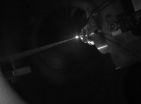(Press-News.org) TORONTO, March 11, 2014 – Anesthesiologists using a technique similar to a dental freeze can improve the quality of recovery and decrease recovery time for breast cancer surgery patients, according to a new study.
The study, from researchers at St. Michael's Hospital and Women's College Hospital, was published in the March edition of Anesthesiology. It is the world's first randomized control trial for breast cancer surgery that compares the use of ultrasound-guided paravertebral blocks – a local anesthetic freezing that blocks breast nerves – to general anesthetic. The findings reveal that breast cancer patients who received local anesthetic had superior pain relief, spent less time in recovery rooms after surgery, and were discharged an hour earlier than patients who were put under general anesthesia.
"Real time, image-guided ultrasound nerve blocks have revolutionized the practice of regional anesthesia," said Dr. Faraj Abdallah, an anesthesiologist at St. Michael's Hospital and lead author of the study. "This is the first study to show how effective these ultrasound-guided blocks can now be for breast cancer surgery. Even more importantly, we've been able to demonstrate that blocks help patients feel better and return to their normal levels of mental and physical functionality sooner after surgery."
Dr. Abdallah conducted this randomized controlled trial of 64 women at Women's College Hospital, the first Canadian site to complete a study where this image-guided technique was used in breast cancer surgery. Because of its demonstrated benefits and the addition of Dr. Abdallah, St. Michael's Hospital is working on incorporating this technique into practice in its CIBC Breast Centre.
The paravertebral block technique uses ultrasound to precisely guide a needle to intercostal nerves reaching the breast and deliver local anesthetic to freeze these nerves. In total, five blocks are needed to freeze the five nerves involved. The freeze blocks the transmission of pain from the breast where surgeons can perform full or partial mastectomies, or even reconstructive breast surgery. At the same time, patients are given an intravenous drug called propofol which allows them to sleep through the surgery and continue breathing on their own, without needing a breathing tube or a ventilator.
"There is a global interest in avoiding general anesthesia in breast cancer surgery whenever possible because of potential long-term effects. Although effective, general anesthesia use is also associated with nausea, vomiting and can result in excessive sedation even after surgery," said Dr. Tulin Cil, a study co-author and general surgeon at Women's College Hospital. "Patients who receive general anesthesia also require extra help to look after themselves in the first few days after surgery, whereas patients who received the nerve blocks are much more independent and require less support."
In the past, paravertebral blocks were inserted "blindly" – without the use of guided ultrasound – and, not surprisingly, with a high failure rate.
"Without ultrasound it may take several attempts to administer the blocks," said Dr. Abdallah. "And even then, it would be difficult to tell if they'd hit their mark so patients might feel pain during surgery and would then need to be put under general anesthetic, which defeats the purpose."
Dr. Abdallah said that the benefits of paravertebral blocks following breast cancer surgery would also apply to cosmetic breast surgeries such as reductions or augmentation because the same breast nerves can be frozen in a similar manner.
INFORMATION:
This study was supported by a grant from the Ontario Ministry of Health and Long Term Care's Alternate Funding Plan Innovation Fund.
About St. Michael's Hospital
St. Michael's Hospital provides compassionate care to all who enter its doors. The hospital also provides outstanding medical education to future health care professionals in 27 academic disciplines. Critical care and trauma, heart disease, neurosurgery, diabetes, cancer care, care of the homeless and global health are among the hospital's recognized areas of expertise. Through the Keenan Research Centre and the Li Ka Shing International Healthcare Education Centre, which make up the Li Ka Shing Knowledge Institute, research and education at St. Michael's Hospital are recognized and make an impact around the world. Founded in 1892, the hospital is fully affiliated with the University of Toronto.
Media contacts
For more information, or to arrange an interview with Dr. Abdallah, contact:
Geoff Koehler
Media Relations Adviser
St. Michael's Hospital
416-864-6060 ext. 6537
KoehlerG@smh.ca
To arrange an interview with either Dr. Cil or a patient, contact:
Julie Saccone
Director, Marketing & Communications
Women's College Hospital
416 323-6400 ext. 4054
julie.saccone@wchospital.ca
Anesthetic technique improves quality of recovery for women having breast cancer surgery
2014-03-11
ELSE PRESS RELEASES FROM THIS DATE:
LED lamps: Less energy, more light
2014-03-11
Incandescent light bulbs are now banned in the EU, while energy-saving lamps remain a bone of contention. In 2016, it will be lights out for halogen bulbs over 10 watts as well. LEDs (light-emitting diodes) therefore have the best chance of becoming the light source of the future. Experts reckon that LED retrofit lamps for use in standard bulb fittings will overtake traditional energy-saving bulbs for the first time from 2015. By 2020 it is predicted that LEDs will have captured between 88 and 90 percent of the lighting market. The tiny diodes offer a whole host of advantages ...
X-ray laser FLASH spies deep into giant gas planets
2014-03-11
This news release is available in German.
The atmosphere of gas giants consists mainly of hydrogen, which is the most abundant chemical element in the universe. "We have very little experimental knowledge about the hydrogen in the interior of such planets," says Zastrau. "This is despite our very good theoretical models." The researchers therefore decided to use cold liquid hydrogen as a sample of the planetary atmosphere. "Liquid hydrogen has a density that corresponds to that of the lower atmosphere of such giant gas planets," explains Zastrau. The scientists ...
Cosmetic treatment can open the door to bacteria
2014-03-11
Many people have 'fillers' injected into their facial tissue to give them 'bee-stung lips' or to smooth out their wrinkles. Unfortunately, a lot of cosmetic treatment customers experience unpleasant side effects in the form of tender subcutaneous lumps that are difficult to treat and which - in isolated cases - have led to lesions that simply will not heal. Research recently published by the University of Copenhagen now supports that, despite the highest levels of hygiene, this unwanted side effect is caused by bacterial infection.
Injections of fillers were previously ...
Metallurgical challenges in microelectronic 3D IC packaging technology
2014-03-11
Mobile hand-held consumer electronic products have a rapid growing market today, witnessed by the popularity of Apple products. Most people make their first contact to internet, not by a PC, rather by a smart phone. The phone is no longer a phone, but it provides various functions for communication and for entertainment. Not only we can have recorded information such as books, images, songs, and movies from the phone or i-pad, but also we can have instant information such as traffic jam when we drive home, as well as breaking news at the last moment. It is expected that ...
Type 1 diabetes in adults: Antibody affinity is decisive
2014-03-11
LADA (latent autoimmune diabetes in adults) is a form of type 1 diabetes in adulthood. Like the childhood form, the insulin-producing beta cells of the pancreas are destroyed by the body's own immune system. The progression of the illness is relatively slowly, however, with clinical manifestations not appearing until after the age of 30 and the patients not yet requiring insulin therapy to control blood sugar levels at the beginning of the disease. It is therefore often difficult to differentiate between LADA and type 2 diabetes.
Scientists from the Institute of Diabetes ...
California and Arizona amaze with 2 new species of desert poppy
2014-03-11
Who said that there is only sand in the deserts? Not quite desert roses, two new species of desert poppies from North America prove such statements wrong with their simple beauty. The newly described plants are found in the deserts of California and Arizona and have a vibrant yellow colored inflorescences, typical for all the desert dwellers from the Eschscholzia genus of the poppy family. The study was published in the open access journal PhytoKeys.
Most commonly known for the iconic California Poppy, the state flower of California, Eschscholzia is a genus in the poppy ...
Exotic plant species alter ecosystem productivity
2014-03-11
This news release is available in German.
Halle, Germany/ Missoula, USA/ Berkeley, USA. In their joint publication in the journal „Ecology Letters" German and American biologists have reported an increase in biomass production in ecosystems colonised by non-native plant species. In the face of climate change, these and other changes to ecosystems are predicted to become more frequent, according to the researchers.
All over the world, plant and animal species are increasingly encroaching upon ecosystems where they don't belong as a result of human influence. This ...
Getting hyperspectral image data down to a sprint
2014-03-11
Cameras with hyperspectral sensors can observe far more than the human eye. Unlike the retina, which has only three color receptors (red, green and blue), these sensors can generate 130 different color values per pixel. Using this high-grade color resolution, an entire range of different materials can be differentiated impeccably – even if, at first glance, they appear the same to the human eye. This is because every substance has its own individual color spectrum, irrespective of how its surface reflects the light hitting it. This hyperspectral technology can be used anyplace ...
Study finds CT scans predict chemotherapy response in pancreatic cancer
2014-03-11
Computed tomography (CT) scans routinely taken to guide the treatment of pancreatic cancer may provide an important secondary benefit. According to new research from The University of Texas MD Anderson Cancer Center, the scans also reflect how well chemotherapy will penetrate the tumor, predicting the effectiveness of treatment.
The research, published in the Journal of Clinical Investigation, is the first human study to address the issue of chemotherapy delivery to pancreatic tumors, a problem previously shown in animal studies.
"We found that the distribution of intravenous ...
Filling out those employment questionnaires might reveal more than you think
2014-03-11
Your answers on psychological questionnaires, including some of the ones that some employers give their employees, might have a distinct biological signature. New research indeed demonstrates overlap between what workers feel and what their bodies actually manifest. This is an important occupational health issue when we consider that workplace stress is the leading cause of sick leave related to depression and burnout. Involving over 400 workers from 35 businesses, the research was conducted by the researchers at the University of Montreal, its affiliated Institut universitaire ...






